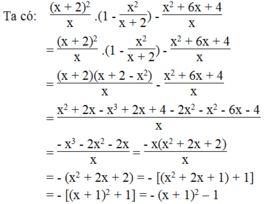
Hãy nhập câu hỏi của bạn vào đây, nếu là tài khoản VIP, bạn sẽ được ưu tiên trả lời.


Ta có :
\(x^2-4x+5=\left(x^2-2.2x+2^2\right)+1=\left(x-2\right)^2+1\ge1>0\)
Vậy đa thức \(x^2-4x+5\) vô nghiệm với mọi giá trị của x
Chúc bạn học tốt ~

a) x ≠ 0 , x ≠ − 2
b) Ta có D = x 2 - 2x - 2.
c) Chú ý D = - x 2 - 2x - 2 = - ( x + 1 ) 2 - 1 ≤ -1. Từ đó tìm được giá trị lớn nhất của D = -1 khi x = -1.

a) ĐKXĐ : \(\hept{\begin{cases}x\ne0\\x\ne-2\end{cases}}\)
\(N=\frac{\left(x+2\right)^2}{x}.\left(1-\frac{x^2}{x+2}\right)-\frac{x^2+6x+4}{x}\)
\(N=\frac{\left(x+2\right)^2}{x}.\frac{x+2-x^2}{x+2}-\frac{x^2+6x+4}{x}\)
\(N=\frac{\left(x+2\right)\left(x+2-x^2\right)-x^2-6x-4}{x}\)
\(N=\frac{x^2+2x-x^3+2x+4-2x^2-x^2-6x-4}{x}\)
\(N=\frac{-x^3-2x^2-2x}{x}\)
\(N=\frac{-x\left(x^2+2x+2\right)}{x}\)
\(N=-\left(x^2+2x+2\right)\)
b) \(N=-\left(x^2+2x+2\right)\)
\(\Leftrightarrow N=-\left(x^2+2x+1+1\right)\)
\(\Leftrightarrow N=-\left(x+1\right)^2-1\le-1\)
Max N = -1 \(\Leftrightarrow x=-1\)
Vậy .......................

A+1 = x^2+6x+9/x^2+1 = (x+3)^2/x^2+1 >= 0
=> A >= -1
Dấu "=" xảy ra <=> x+3=0 <=> x=-3
Vậy GTNN của A = -1 <=> x=-3
Tk mk nha

\(a,\\ A=25x^2-10x+11\\ =\left(5x\right)^2-2.5x.1+1^2+10\\ =\left(5x+1\right)^2+10\ge10\forall x\in R\\ Vậy:min_A=10.khi.5x+1=0\Leftrightarrow x=-\dfrac{1}{5}\\ B=\left(x-3\right)^2+\left(11-x\right)^2\\ =\left(x^2-6x+9\right)+\left(121-22x+x^2\right)\\ =x^2+x^2-6x-22x+9+121=2x^2-28x+130\\ =2\left(x^2-14x+49\right)+32\\ =2\left(x-7\right)^2+32\\ Vì:2\left(x-7\right)^2\ge0\forall x\in R\\ Nên:2\left(x-7\right)^2+32\ge32\forall x\in R\\ Vậy:min_B=32.khi.\left(x-7\right)=0\Leftrightarrow x=7\\Tương.tự.cho.biểu.thức.C\)
b:
\(D=-25x^2+10x-1-10\)
\(=-\left(25x^2-10x+1\right)-10\)
\(=-\left(5x-1\right)^2-10< =-10\)
Dấu = xảy ra khi x=1/5
\(E=-9x^2-6x-1+20\)
\(=-\left(9x^2+6x+1\right)+20\)
\(=-\left(3x+1\right)^2+20< =20\)
Dấu = xảy ra khi x=-1/3
\(F=-x^2+2x-1+1\)
\(=-\left(x^2-2x+1\right)+1=-\left(x-1\right)^2+1< =1\)
Dấu = xảy ra khi x=1

Điều kiện x ≠ -2 và x ≠ 0

Vì x + 1 2 ≥ 0 nên - x + 1 2 ≤ 0 ⇒ - x + 1 2 - 1 ≤ - 1
Khi đó biểu thức có giá trị lớn nhất bằng -1 khi x = -1
Vậy biểu thức đã cho có giá trị lớn nhất bằng -1 tại x = -1.

`A=x^4-6x^3+18x^2-6xy+y^2+2012`
`=x^4-6x^3+9x^2+9x^2-6xy+y^2+2012`
`=(x^2-x)^2+(3x-y)^2+2012>=2012`
Dấu "=" xảy ra khi:
$\begin{cases}x=x^2\\y=3x\end{cases}$
`<=>` $\left[ \begin{array}{l}\begin{cases}x=0\\y=3x=0\\\end{cases}\\\begin{cases}x=1\\y=3x=3\\\end{cases}\end{array} \right.$
Vậy `min_A=2012<=>` $\left[ \begin{array}{l}x=y=0\\\begin{cases}x=1\\y=3\end{cases}\end{array} \right.$
A= 1 + 6x - x2
A = -(x2 - 6x + 9) +9
A = -(x-3)2 + 9
-(x-3)2 ≤ 0 ⇔ -(x-3)2 + 9 ≤ 9 ⇔A(max) = 9 ⇔ x = 3